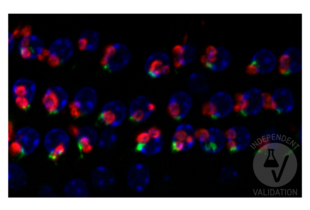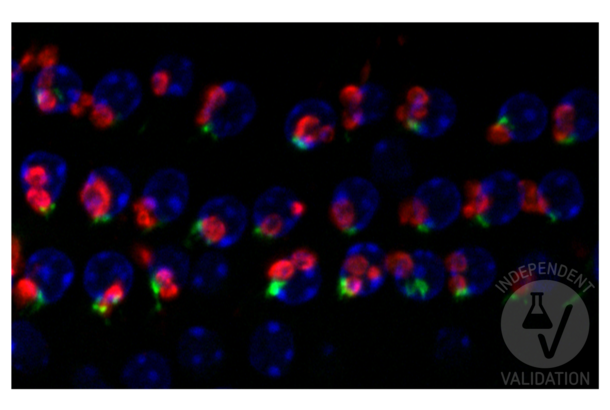Solute Carrier Family 18 (Vesicular Acetylcholine), Member 3 Anticorps

 SLC18A3 anticorps (C-Term) (ABIN1742304)
SLC18A3 anticorps (C-Term) (ABIN1742304)
SLC18A3 Reactivité: Rat, Souris WB, IHC Hôte: Cobaye Polyclonal unconjugated
SLC18A3 Reactivité: Humain WB, IHC, IF, ICC Hôte: Souris Monoclonal S6-38 unconjugated
SLC18A3 Reactivité: Humain WB, IHC, IF, ICC Hôte: Souris Monoclonal S6-38 HRP
Solute Carrier Family 18 (Vesicular Acetylcholine), Member 3 Anticorps par Réactivité
Trouvez Solute Carrier Family 18 (Vesicular Acetylcholine), Member 3 Anticorps pour une variété d'espèces telles que anti-Human Solute Carrier Family 18 (Vesicular Acetylcholine), Member 3, anti-Rat Solute Carrier Family 18 (Vesicular Acetylcholine), Member 3, anti-Mouse Solute Carrier Family 18 (Vesicular Acetylcholine), Member 3. Les espèces listées ci-dessous sont parmi celles disponibles. Cliquez sur un lien pour accéder aux produits correspondants.
Solute Carrier Family 18 (Vesicular Acetylcholine), Member 3 Anticorps par Application
Trouver Solute Carrier Family 18 (Vesicular Acetylcholine), Member 3 Anticorps validé pour une application spécifique telle que WB, IF, IHC, ICC. Certaines des applications disponibles sont énumérées ci-dessous. Cliquez sur un lien pour accéder aux produits correspondants
Solute Carrier Family 18 (Vesicular Acetylcholine), Member 3 Anticorps par Hote
On trouve ici des Solute Carrier Family 18 (Vesicular Acetylcholine), Member 3 Anticorps avec un Hote spécifique. Les Hote mentionnés ici sont quelques-uns de ceux qui sont disponibles. Un clic sur le lien correspondant permet d'accéder aux produits
Solute Carrier Family 18 (Vesicular Acetylcholine), Member 3 Anticorps par Epitope
Trouver Solute Carrier Family 18 (Vesicular Acetylcholine), Member 3 Anticorps avec un épitope spécifique. Les épitopes listés ci-dessous sont parmi ceux disponibles. Cliquez sur un lien pour accéder aux produits correspondants.
Solute Carrier Family 18 (Vesicular Acetylcholine), Member 3 Anticorps par Clonalité
Trouvez les Solute Carrier Family 18 (Vesicular Acetylcholine), Member 3 Anticorps monoclonaux ou polyclonaux disponibles. Cliquez sur un lien pour accéder aux produits correspondants.
Solute Carrier Family 18 (Vesicular Acetylcholine), Member 3 Anticorps par Clone
On trouve ici des Solute Carrier Family 18 (Vesicular Acetylcholine), Member 3 Anticorps avec un Clone spécifique. Les Clone mentionnés ici sont quelques-uns de ceux qui sont disponibles. Un clic sur le lien correspondant permet d'accéder aux produits
Solute Carrier Family 18 (Vesicular Acetylcholine), Member 3 Anticorps par Conjugué
Trouvez Solute Carrier Family 18 (Vesicular Acetylcholine), Member 3 Anticorps avec un conjugué spécifique tel que Biotin, APC, FITC. Les conjugués listés ci-dessous sont parmi ceux disponibles. Cliquez sur un lien pour accéder aux produits correspondants.
Solute Carrier Family 18 (Vesicular Acetylcholine), Member 3 Anticorps fréquemment utilisés
- (4)
- (3)
- (1)
- (3)
- (3)
- (3)
- (3)
- (3)
- (3)
- (3)
- (3)
- (3)
- (3)
- (3)
- (2)
- (2)
- (2)
Dernières publications pour nos Solute Carrier Family 18 (Vesicular Acetylcholine), Member 3 Anticorps
: "Glutamatergic and central cholinergic dysfunction in the CA1, CA2 and CA3 fields on spatial learning and memory in chronic cerebral ischemia-Induced vascular dementia of rats." dans: Neuroscience letters, Vol. 620, pp. 169-176, (2016) (PubMed).: "Deletion of neurturin impairs development of cholinergic nerves and heart rate control in postnatal mouse hearts." dans: Physiological reports, Vol. 4, Issue 9, (2016) (PubMed).
: "An animal model of Miller Fisher syndrome: Mitochondrial hydrogen peroxide is produced by the autoimmune attack of nerve terminals and activates Schwann cells." dans: Neurobiology of disease, Vol. 96, pp. 95-104, (2016) (PubMed).
: "Neuregulin-1 is concentrated in the postsynaptic subsurface cistern of C-bouton inputs to α-motoneurons and altered during motoneuron diseases." dans: FASEB journal : official publication of the Federation of American Societies for Experimental Biology, Vol. 28, Issue 8, pp. 3618-32, (2014) (PubMed).
: "Effect of neurturin deficiency on cholinergic and catecholaminergic innervation of the murine eye." dans: Experimental eye research, Vol. 122, pp. 32-9, (2014) (PubMed).
: "Individual synaptic vesicles from the electroplaque of Torpedo californica, a classic cholinergic synapse, also contain transporters for glutamate and ATP." dans: Physiological reports, Vol. 2, Issue 1, pp. e00206, (2014) (PubMed).
: "Inhibition of neuronal apoptosis and axonal regression ameliorates sympathetic atrophy and hemodynamic alterations in portal hypertensive rats." dans: PLoS ONE, Vol. 9, Issue 1, pp. e84374, (2014) (PubMed).
: "Muscarinic cholinergic receptor M1 in the rat basolateral amygdala: ultrastructural localization and synaptic relationships to cholinergic axons." dans: The Journal of comparative neurology, Vol. 521, Issue 8, pp. 1743-59, (2013) (PubMed).
: "Forced desynchrony reveals independent contributions of suprachiasmatic oscillators to the daily plasma corticosterone rhythm in male rats." dans: PLoS ONE, Vol. 8, Issue 7, pp. e68793, (2013) (PubMed).
: "Genetic deficiency of GABA differentially regulates respiratory and non-respiratory motor neuron development." dans: PLoS ONE, Vol. 8, Issue 2, pp. e56257, (2013) (PubMed).
Pseudonymes pour Solute Carrier Family 18 (Vesicular Acetylcholine), Member 3 Anticorps
solute carrier family 18 member A3 (Slc18a3) Anticorpssolute carrier family 18 (vesicular acetylcholine transporter), member 3b (slc18a3b) Anticorps
solute carrier family 18 member A3 (SLC18A3) Anticorps
solute carrier family 18 (vesicular monoamine), member 3 (Slc18a3) Anticorps
solute carrier family 18 (vesicular acetylcholine transporter), member 3 (slc18a3) Anticorps
Vesicular acetylcholine transporter (VAChT) Anticorps
solute carrier family 18 (vesicular acetylcholine transporter), member 3a (slc18a3a) Anticorps
CG12345 Anticorps
CG32848 Anticorps
CT41182 Anticorps
Dmel\\CG32848 Anticorps
MGC64220 Anticorps
rVAT Anticorps
Slc18a3 Anticorps
SLC18A3 Anticorps
VACht Anticorps
VACHT Anticorps
VAChT Anticorps
Vacht Anticorps
vAChT Anticorps
vacht Anticorps
VAChT-A Anticorps
VAT Anticorps
zgc:153442 Anticorps
Avez-vous cherché autre chose?
- Solute Carrier Family 17 (Vesicular Glutamate Transporter), Member 6 Anticorps
- Solute Carrier Family 17 (Acidic Sugar Transporter), Member 5 Anticorps
- Solute Carrier Family 16, Member 9 (Monocarboxylic Acid Transporter 9) Anticorps
- Solute Carrier Family 14 (Urea Transporter, Kidney) Member 2 Anticorps
- Soluble Tumor Necrosis Factor Receptor Type 2 Anticorps
- SOHLH2 Anticorps
- SOHLH1 Anticorps
- SOGA1 Anticorps
- Sodium Potassium ATPase, alpha1 Anticorps
- Sodium Channel, Voltage-Gated, Type IV, beta Subunit Anticorps
- Sodium Channel, Nonvoltage-Gated 1, gamma Anticorps
- Sodium Channel, Nonvoltage-Gated 1, beta Anticorps
- SOD4 Anticorps
- SOD3 Anticorps
- SOD2 Anticorps
- SOCS7 Anticorps
- SOCS6 Anticorps
- SOCS5 Anticorps
- SOCS4 Anticorps
- SOCS3 Anticorps
- Solute Carrier Family 22 (Organic Cation Transporter), Member 7 Anticorps
- Solute Carrier Family 25 (Mitochondrial Carrier, Phosphate Carrier), Member 3 Anticorps
- Solute Carrier Family 25, Member 28 Anticorps
- Solute Carrier Family 25, Member 44 Anticorps
- Solute Carrier Family 3 (Activators of Dibasic and Neutral Amino Acid Transport), Member 2 Anticorps
- Solute Carrier Family 3 Member 1 Anticorps
- Solute Carrier Family 30 (Zinc Transporter), Member 1 Anticorps
- Solute Carrier Family 31 (Copper Transporters), Member 2 Anticorps
- Solute Carrier Family 34 (Type II Sodium/phosphate Contransporter), Member 1 Anticorps
- Solute Carrier Family 35 (UDP-GlcNAc/UDP-Glucose Transporter), Member D2 Anticorps
- Solute Carrier Family 38, Member 7 Anticorps
- Solute Carrier Family 39 (Zinc Transporter), Member 9 Anticorps
- Solute Carrier Family 40 (Iron-Regulated Transporter), Member 1 Anticorps
- Solute Carrier Family 43, Member 1 Anticorps
- Solute Carrier Family 43, Member 2 Anticorps
- Solute Carrier Family 5 (Sodium/glucose Cotransporter), Member 12 Anticorps
- Solute Carrier Family 5 (Sodium/inositol Cotransporter), Member 11 Anticorps
- Solute Carrier Family 52 (Riboflavin Transporter), Member 3 Anticorps
- Solute Carrier Family 6 (Neurotransmitter Transporter, serotonin), Member 4 Anticorps
- Solute Carrier Family 6 (Neutral Amino Acid Transporter), Member 19 Anticorps




